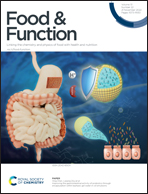Antiproliferative potential of Physalis peruviana-derived magnolin against pancreatic cancer: a comprehensive in vitro and in silico study†
Abstract
Physalis peruviana L. is a common edible fruit in Egypt and other regional countries. In the present study, we investigated its crude extract as a potential source of antiproliferative secondary metabolites. Upon bioactivity guided solvent fractionation, ethyl acetate extract showed preferential activity toward the human pancreatic cancer cell line PANC-1 with an IC50 value of 5.23 ± 0.2 μg mL−1. The subsequent HR-LCMS-guided and biological activity-guided isolation revealed magnolin as a potent preferential antiproliferative agent against PANC-1 with an IC50 of 0.51 ± 0.46 μM that was comparable to that of the positive control doxorubocin (IC50 of 0.17 ± 0.15 μM). Moreover, magnolin showed much less cytotoxicity in comparison with the positive control doxorubicin (6.96% and 30.48% growth inhibition, respectively, at 5 μg mL−1) towards normal human cells (i.e. dermal fibroblasts; HDFa). Furthermore, magnolin was able to induce a concentration-dependent suppression of the formation of PANC-1 colonies, where the treatment of the tumor cells with 25 nM, 50 nM, and 100 nM concentrations of the compound resulted in a 36%, 57, and 78% reduction, respectively, in the PANC-1 colony formation. Additionally, magnolin was observed to limit PANC-1 tumor cell migration in the tumor cell wound healing assay, indicating a substantial anti-migratory effect against the PANC-1 cell line. A subsequent in silico-based study of this compound structure putatively suggested matrix metalloproteinase-3 (MMP3) as the molecular target that mediates these observed effects on PANC-1 cells. Absolute binding free energy estimation (ΔGbinding) and 100 ns long molecular dynamics simulation (MDS) experiments indicated that the magnolin structure has good affinity towards the MMP3's active site and can achieve significantly stable binding inside it. Accordingly, upon experimental validation, magnolin was found to inhibit the catalytic activity of MMP3 in a dose-dependent manner with a nanomolar IC50 value of 185 nm ± 4.86 and a Ki of 112 nm ± 6.31. In conclusion, our results clearly revealed that magnolin derived from P. peruviana is an interesting antiproliferative and antimetastatic agent against PANC-1 cells with potent inhibitory activity against MMP3. Further in vivo evaluation will be of great interest in the future.



 Please wait while we load your content...
Please wait while we load your content...